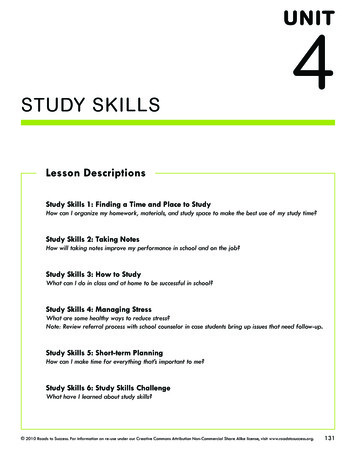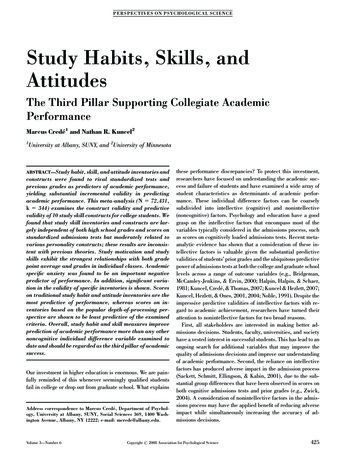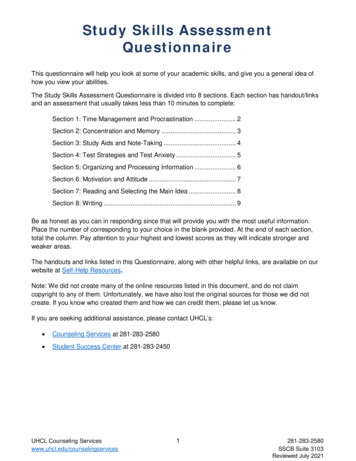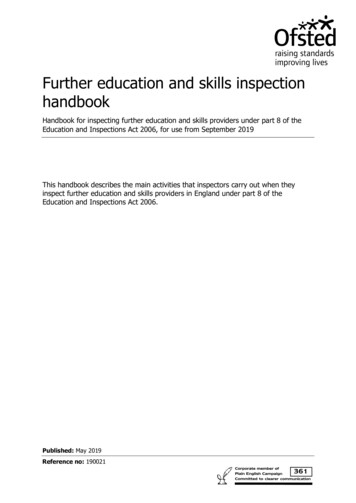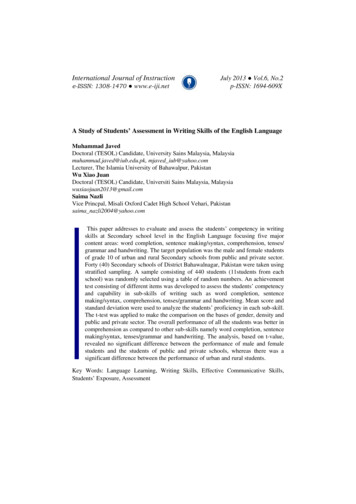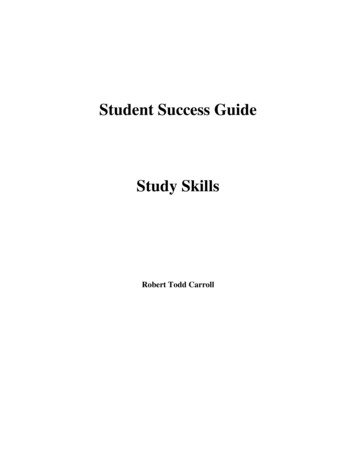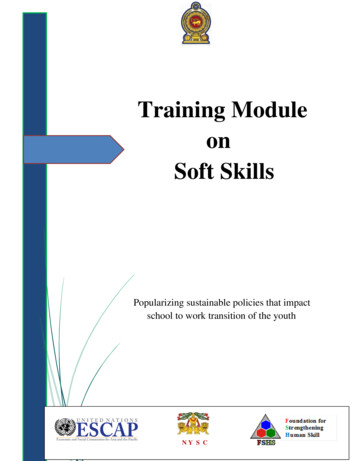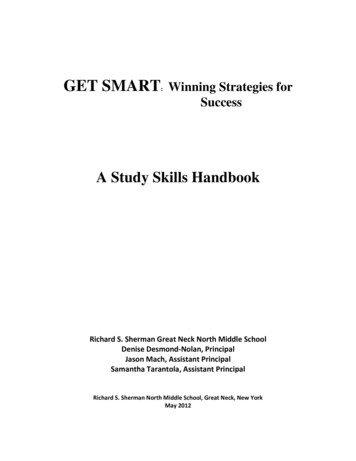
Transcription
GET SMART:Winning Strategies forSuccessA Study Skills HandbookRichard S. Sherman Great Neck North Middle SchoolDenise Desmond-Nolan, PrincipalJason Mach, Assistant PrincipalSamantha Tarantola, Assistant PrincipalRichard S. Sherman North Middle School, Great Neck, New YorkMay 2012
CREDITSDenise Desmond-Nolan, PrincipalLeslie Blank, Mathematics Department ChairEllen Bronheim, Social Studies Department ChairMichael Greenberg, English Department ChairNancy Intersimone, Reading Department ChairMarsha Witten, Library Media Specialistii
PREAMBLEThis handbook has been compiled for students and staff in an effort topromote higher standards of reading, writing, and research at North MiddleSchool, and to ensure consistency in models of instruction throughout all threegrade levels. Included are guidelines for written work, word processing, and theresearch process. Seventh and eighth graders who have experienced the sixthgrade skills program will find new strategies in this handbook to handle morechallenging material, and to enhance performance on New York Stateassessments. Through repetition and review of these life skills, we can helpstudents become independent learners.iii
Study Smart: Winning Strategies for SuccessTable of ContentsCredits iiPreamble iiiI.Learning Skills .Students’ Responsibility for Success .North Middle School Guidelines for Written Work North Middle School Guidelines for Word Processed Documents .Studying at Home .Your Check-up for Success .Preparing to Succeed on Tests .Memory Checklist .Memory Techniques .Test Taking Strategies – Reading Passages Test Taking Strategies – How to Answer Multiple Choice Questions .Test Taking Strategies .Math Strategies .13456789910111314II.Reading Strategies .How to Read a Textbook .How to Read a Chapter in a Textbook .When Reading is Tough .How to Read a Foreign Language Textbook .How to Read a Bar Graph How to Read a Line Graph .How to Read a Circle Graph 1517181920212222III. Notetaking & Outlining .Introduction to Notetaking Highlighting Listening .How to Paraphrase How to Summarize Criteria for Good Notes .Cornell Notetaking Format .Cornell Notetaking Format Example .Rules for a Harvard Outline .A Harvard Outline Example .Notetaking as a Study Tool .232525262727282829303132
IV.Writing . .Writing .Step 1: Pre-writing .Step 2: Writing a First Draft .Step 3: Revising Step 4: Publishing 333536384546V.Writing Aids .Graphic Organizers .The Five Paragraph Thematic Essay .The Five Paragraph Thematic Essay Template Venn Diagram for Compare/Contrast .Concept Map .Inspiration: Character Web .Transitions .Frequently Asked Questions About Grammar and Usage .474950515253545556VI.Oral Presentations and Speeches .Types of Speeches Visual Aids to Enhance Oral Presentations .Steps Necessary for Effective Speaking 59616162VII. Information/Research .Research Process Checklist North Middle School’s Checklist for Finding Facts .Key Word Search .Online Searching .Taking Notes for Research .Checklist for Notecards .Notetaking for Research .Bibliography Cards Guidelines for Bibliographies .Example of a Bibliography .6365666769707273747879
VIII. Reference . .81Document Checklist . .83How to Read a Biography . 84How to Read a Novel . .85How to Read a Play . .86How to Read a Poem . .87How to Read a Short Story .88Literary Terms You Should Know . .89Glossary of Library/Reference Terms .90Common Math Formulas . 92Tables .93Lab Report Format . .94Periodic Table .95Responding to DBQ Essays .96DBQ Tips .97Responding to Documents .98How to Read a Political Cartoon .99Acknowledgments . 100
LEARNING SKILLS
STUDENTS’ RESPONSIBILITIES FOR SUCCESSBeing prepared for class means being on time, having the right tools, and beingready to work.Loose-leaf binder must be brought to class every day. It must be kept organized,neat, and complete. Divide it into sections according to your teachers’ instructions.Make sure to date all notes. Please note: North Middle School is a backpack freeenvironment; therefore, morning and afternoon binders are suggested.Blue or black pen will be used for written work in most subject areas; math work isusually done in pencil. See your teacher for instructions.Homework assignments are to be done neatly and completely. In addition, you areresponsible for rereading and reviewing notes each day.Classwork counts! Your participation in class and group activities will not only allowyou to learn more, but will also make the work interesting. If you are absent fromclass, see your teacher about making up missed work.Supplies needed:Agenda BookLoose-leaf – 3 ring binder with dividers and reinforcementsPaper – standard rule, 3 hole punchPencil case with 2 pens, 2 pencils, erasers, highlighters and optionalmarkers ,12” rulerIndex cardsHomework Buddy – For each subject area, select a reliable classmate tocall when you are absent. Also check to see if your teacher posts assignments online.3
NORTH MIDDLE SCHOOL GUIDELINESFOR WRITTEN WORK1. Use 8 ½ “ by 11” lined looseleaf paper.2. Place the heading on the first blue line near the left margin:Name(John Brown)Subject, Grade, Period(English 7 – 2)Teacher’s Name(Ms. White)Due Date(9/1/12)3. Skip a line after the heading and center the title. Remember to:Capitalize the first word and all other important words.Underline titles of books, newspapers, magazines, plays, and films.Place quotation marks around the titles of poems, short stories, and essays.4. Skip a line after the title, and begin the body of the report on the next line.5. Indent paragraphs one inch.6. Use both sides of the paper unless otherwise requested.7. Be sure to proofread your paper.8. Remove errors neatly.9. Use a dictionary and thesaurus.10. Learn the following correction symbols which may be used by your teacher.cap error in capitalizationW W word not well chosenNS not a sentence¶ new paragraphRO run-on sentenceK awkward word or phrase omitted word or phraseP punctuationXobvious errorSP spelling error (word mayHillegible handwritingalso be circled) reverse orderYour writing will be evaluated on the basis of context, style, and mechanics.4
NORTH MIDDLE SCHOOL GUIDELINES FORWORD PROCESSED DOCUMENTSUnless otherwise instructed, follow all the instructions below when wordprocessing a document.1. Place the heading in the top left corner of the screen:Name(John Brown)Subject, Grade, Period(English 7 – 2)Teacher’s Name(Ms. White)Date Due(9/1/12)2. Press return twice after the heading.3. Move your cursor to the body of your document. Change the line spacing to 1.5 li.4. Center and type your title. Capitalize the first word of the title and all other important words.Press return twice, then left justify.5. Begin word processing your document.Remember to:Press tab once to indent the first paragraph and every new paragraphthereafter.Use italics or underline titles of books, newspapers, magazines, plays,and films.Place quotation marks around the titles of poems, short stories, and essays.Put one space after all types of punctuation.6. Use the spell checker to check spelling and correct errors. Use a regular dictionary to checkfor errors that the word processing program might miss (e.g. homonyms).7. Use the thesaurus to find words which will enhance your writing.8. Carefully proofread, spell, and grammar check your document. Make all necessarycorrections.9. Save and print a final draft to give to your teacher.5
STUDYING AT HOME1. Location and Equipment:Set aside a special place where you can study.Have all the necessary equipment at your place of study (e.g., index cards,rulers, pens, pencils). Have your computer handy if you need it. Use yourhomework organizer to set your priorities for the most effective use of studytime.2. Preparation:Organize your notes and work each day. Put them into proper order in yourlooseleaf.3. Time:Spend at least 15 minutes reviewing, rereading, or rewriting material coveredin class.Break large assignments into smaller manageable units.Use a calendar to organize long-term assignments.4. Study Aids:Use a highlighter to underline key words in handouts and notes.Use index cards to help you study.o Color code index cards by subject. Write vocabulary words, concepts,phrases, dates, formulas, rules, etc. on the unlined side of the card.Write definitions, explanations, etc. on the lined side.o File by subject in a secure container.Learn to use mnemonic devices and other memory strategies.6
YOUR CHECK-UP FOR SUCCESSHOMEWORK CHECKLIST1. Before you leave school, ask yourself these questions:Did I write down my homework assignments completely for every classincluding due dates?Did I gather all my materials together?Did I number each assignment in the order of deadlines?2. As you work on the assignment, ask the following questions:Do I know what I have to learn or read?Am I concentrating?Do I understand what I am reading or doing?Could I explain this information so someone else could understand it?3. When you think you have finished the assignment, ask these questions:Have I reread the homework assignment?Have I completed the assignment?o Is my work good enough?o What corrections do I need to make?o Do I understand the material?o Do I understand the assignment?REWARD YOURSELF!7
PREPARING TO SUCCEED ON TESTSWhat to Study, How to Study1. What to study:Notes from class lessonsHomeworkTextbook readingsWorksheets, maps, charts, graphs, labs, diagrams, formulasVocabulary words2. How to study:Read all notes.Say notes aloud.Rewrite notes in a briefer form (note shrink).Write margin questions.Make flash cards for your notes and any unfamiliar vocabulary,then quiz yourself.Review any worksheets, maps, charts, graphs, labs, diagrams,formulas.Reread pages from textbook.Find a “study-buddy” and quiz each other.Create your own practice quizzes.Check the computer for helpful tutorials.Come for extra help!!3. Preparing for essay questions:Anticipate questions the teacher might ask.Sketch a variety of outline responses to model questions.Practice writing sample essays.REMEMBER: If you have been reviewing your notes all along (within 24 hours oflearning), you will not have much difficulty studying because the information will bein your long-term memory. Some of you will need to follow more of the above stepsthan others. You should, by now, have a sense of how much you need to study.8
MEMORY CHECKLISTUse this checklist to ensure that you have followed the steps for learningmaterial.Have I made a list of the things I need to remember?Did I divide the list into small pieces to memorize?Did I rehearse this small group by saying the items aloud or by writing themdown?Did I test myself to see how well I learned the group?Did I practice the items I missed?Have I gone back and tested myself?Have I repeated items three through six until I am sure that I have memorizedmy work?Have I allowed a few minutes each day and just before a test to refresh mymemory?MEMORY TECHNIQUESThe following are some examples of memory techniques you can use tohelp you review information:Record the information to be learned, and use it for review.Practice memorizing through writing and rewriting the materialPractice memorizing by verbal rehearsalUse mnemonic devices to help remember subject matter.o For example: Order of OperationsPlease Excuse My Dear Aunt SallyParenthesis, Exponents, Multiplication, Division, Addition, Subtraction9
TEST TAKING STRATEGIESReading Passages1.Reading the passage successfullyRequires focus and active involvement with the materialMust overcome distractionsImpossible to focus on two things at once2.Sources of distractionsNervousnessNoises in classroomProblems at homePassage too long, too boring, too difficult3.Tricks to help focus: “about-point”Read one paragraph.Ask what this paragraph is about.o It is easy to focus on such a short task and to state the topic of oneparagraph.Label the paragraph in the margin with this topico Use only a word or phrase, not a full sentence. Your label is not themain idea.Reread all the paragraph labels when you’ve completed reading thepassage .Ask what the whole passage is about.o All of the paragraph topics combined will lead you to the topic of theentire passage.Ask what the author’s point is.o Your answer will be the main idea of the entire passage. It will bea perfect fit, not too broad, not too narrow.See page 274.Three Ways to use paragraph labelsTo locate information in the passage.o Knowing where to find facts in a long passage to answer a specificquestion will save you time.To determine the main idea of the passage.o The correct answer to a question concerning the main idea, theauthor’s purpose, or his overall approach must include the majorityof the topic labels, no more, no less. Test writers try to trick youwith answers that state true facts but don’t match all the labels.To concentrate while reading.o Using the “About Point” labeling strategy keeps your mind activelyengaged so you won’t fall prey to distractions.10
TEST TAKING STRATEGIESHow to Answer Multiple-Choice QuestionsMultiple-choice questions are either incomplete statements followed by a number of possibleendings or questions followed by a list of possible answers. You have to choose which endingor answer is correct.1.Read the questions carefully.Underline key words.Circle any negative words such as not or except.Circle any absolute words such as never, always, worst, best, no, none, all,every, nobody, and everybody. Negatives and absolutes are often misleading andfrequently cause errors.2.Try to provide your own answer without looking at the choices.You should go back to the passage to confirm your thoughts or find the correctresponse.3.Locate the answer to a detail question in the passage.Use the paragraph topic labels to find the information.Mark the information with the number of the question.4.Base answers to main idea questions or author’s purpose questions onthe complete passage.Don’t select a true fact that is mentioned in only one part of the passage.Read all margin notes and select the answer that incorporates most of those topics.5.Read all the answer choices.If one matches your answer, it’s probably correctBe sure to read all the remaining choices.Circle negative words and absolute words to avoid careless errors.11
6.Narrow the field of choices by a process of elimination.Get rid of choices you know are wrong.Eliminate choices that are contrary to facts in the passage.Eliminate silly answers.Eliminate those containing absolute words like never, always, worst, best, no,none, all, every, nobody, and everybody.7.Use these tips for guessing:Never leave a question unanswered; guess after narrowing down the field.If there are two similar-looking answers in your group of choices, one of them isprobably correct.If there are two answers that mean the same thing, neither can be correct.In questions where a choice is all of the above, this tends to be a correct answer,especially if two of the other choices are correct.If two choices are exact opposites, one of them is probably correct.If one choice is much longer than the rest, and it seems likely to be right, go with it;longer answers tend to be right more often than shorter ones.12
TEST TAKING STRATEGIES1. For Short Answer Questions:Answer easiest questions first.Underline key words to determine what the question is asking.Cross out items you have answered.Be alert for words such as “always” and “never.”Check your answer. Make sure you’ve answered the question completelyIf there is no penalty for guessing, answer every question.2. For Essay Questions:Read each question carefully and underline key words.Analyze the task before beginning to write.Create an informal “cluster” outline of your response before starting to write.Strive for a focused essay, tightly organized, and supported with facts.3. Responding to Thematic Essay Questions on Tests: Refer to writing sections on page 35 .o For analyzing the tasko For planning your responseo For writing your essayRefer to the Reference Section pages 96 and 97 for responding to DBQ’s.13
MATH STRATEGIESPlan for Solving Word ProblemsPREVIEWFirst read the problem once from beginning to end.READReread the problem slowly and carefully.Be sure you know the meaning of all the wordsWatch for keywords such as “all together,” “about,” etc.Watch for boldfaced words.PLANHighlight or underline the facts.Draw a diagram, sketch a picture, or create a chart that will helpvisualize the problem.Write a formula if one is to be used.Substitute the information given into the formula.If you are not using a formula, decide what operation oroperations you will use to solve the problemEstimate the possible answer.SOLVEWork the problem out. Be careful that your calculations areaccurate.Double check your computations.Check your results with the facts given in the problem. Did you answer the questions asked? Does the answer make sense? Is your answer reasonable?CHECK14
READING STRATEGIES
HOW TO READ A TEXTBOOK1. Preview the whole bookExamine the table of contents.Check for a glossary.Look for an index.Note other special aids including gazetteers, atlases, and review problems.2. Preview the chapterRead the title.Read the introductory paragraph.Read the boldfaced headings.Look at charts, pictures, graphs, tables, cartoons, etc.Read captions under illustrations.Read the concluding paragraph or summary.Read the questions at the end of the chapter.3. Read the assignmentReview the essential questions or change boldfaced headings intoquestions, and read for an answer.Note boldfaced or italicized words or phrases.Make a list of important terms, names, and dates. Keep an ongoing list ofnew vocabulary words with their meanings.As you finish reading a section, write a brief summary.Use your notes to answer the questions at the end of the chapter.Test yourself on the information.17
HOW TO READ A CHAPTERIN A TEXTBOOKUse this study formula: PQ3RP PREVIEWLook over the assigned pages before beginning to read.Q QUESTIONTurn titles and boldfaced headings into questions or noteessential questions provided.R RELATEThink about what you already know.R READActively involve yourself in the overall topic.ask what you’d like to know.R RESPONDState the answers to these questions by:taking notesparaphrasing the informationwriting a summary of what you have read18
WHEN READING IS TOUGHSometimes your ordinary reading style does not work. If you are not getting it, trythe following techniques:Break the material down into smaller sectionsLook for key words, especially nouns and verbs.Label the topic of each paragraph. Use no more than a word or phrase.Read it again. Difficult reading material is often easier to understand when reada second time.Check for understanding. Go back to the point where your understanding brokedown, and try to see that your topic heading reflects the content of eachparagraph accurately.Read it aloud. Imagine you are trying to help someone else understand it.Stand up. Change positions or walk around as you read aloud.19
HOW TO READ AFOREIGN LANGUAGE TEXTBOOKUse the formula: P3RP PREVIEWLook over the chapter to be read.Check for new vocabulary/grammatical structure/culture.Notice what new material has been introduced.R RELATEWhen possible, relate new vocabulary to previously learned words.R READRead each sentence from the beginning to end without looking upwordsTry to guess the meaning of new words.Look up words to verify your guesses only after you have read eachsentence and cannot make sense of the meaning.Read out loud: This gives you additional oral practice.Reread the selections until you know them.Rereading is essential.R REVIEWLearn the vocabulary.Grammatical structures and verbs given in each chapter should bememorized.Work with another student to review.Drill as often as necessary.20
HOW TO READ A BAR GRAPHTo understand a bar graph look for the main parts.TITLE:Look for the title at the top of the graph. This gives you the topicor subject of the graph.LEGEND/KEY:Look for the key or legend to help you interpret the graph.The legend explains what each bar or pattern represents.Not all graphs have legends.AXIS:Find the vertical axis. The information on this part of thegraph runs from top to bottom. Note the informationgiven on this part of the graph.Find the horizontal axis. The information on this part ofthe graph runs from left to right. Read the informationgiven on this part of the graph.INTERPRET: To interpret the information on the graph, you must usethe information on each axis to draw conclusions.Example1. Look at the title2. Examine both axes.3. To interpret the information go to the horizontal axis.Place you finger on the bar reading 1880.Run your finger up to the top of the bar.Next, run your finger across to the left to thevertical axis.Look at the number scale on the vertical axis.You will see that bar ends at a little more than700,000.Question: What have you found out from the informationgiven on the graph?Answer: There were approximately 750,000 businesses in America in 1880. And, if you read theentire graph, you can see how American businesses have grown from 1870 to 1900.21
HOW TO READ A LINE GRAPHLine graphs are particularly useful forshowing change over time.Read the labels on both the horizontal axis andthe vertical axis. Then look to see howthey relate to the subject of the graph.Question: What percentage of Native Americanmales died at age 30?Answer: At age 30, 20% of Native Americanmales died.HOW TO READ A CIRCLE GRAPHRetail Sales of PastaA circle graph is used to compare parts of awhole. The circle represents the whole.The circle is separated into parts of thewhole.By looking at the graph on the right, you can tellthat long pasta is the most popular in retail salesbecause it is the largest part of the graph.You can also tell that long pasta is the mostpopular because it has the largest number, 0.41or 41% of the sales.22
NOTETAKING&OUTLINING
INTRODUCTION TO NOTETAKINGAs a student, you will be expected to take notes for many purposes and under manycircumstances including those listed below.Oral SourcesWritten Sourcesteacher’s lecturesclassmates’ presentationsclass discussionspreparation for testsfilms in classshort storiesnovelsessaysnonfiction textsmagazines and newspaper articlesInternet source materialTaking notes from oral sources is very different from, and often more difficult, thantaking notes from written material.HIGHLIGHTINGHighlighting is the fastest and easiest method of notetaking because it does notrequire forming ideas and writing. The danger is that many people tend to highlighttoo much of the printed material. This method can be used only with books that youown or with handout materials that you may keep.When highlighting, it is important to read the selection first, then go back andhighlight the key ideas (important names, terms, definitions, dates) that will helpanswer the questions you already have noted. In the margin, identify the topic ofthe highlighted portion. If you use this procedure, you will avoid highlighting toomuch.Highlight after reading!25
LISTENINGAN IMPORTANT NOTETAKINGAND LEARNING SKILLDO YOU KNOWAs a student you will spend 55% of your time LISTENING.There is a difference between LISTENING and HEARING.HEARING occurs when the sound waves enter your ear.LISTENING occurs when you use your BRAIN to understand what you hear.The student who LISTENS is the student who learns.LISTENING makes learning easier.Half your knowledge will come from LISTENING.HOW TO BE A GOOD LISTENERGet interested.Focus your attention.Avoid distractions. Listen for directionsListen for key words and ideas.Take notes to keep your mind from wandering.Avoid pen tapping or any activity which will create distractions for you or for others.LISTEN CAREFULLY AND RECORD SIMPLYWrite the general topic immediatelyJust write – don’t try to learn the material.Write when you have heard the main point.Write the information in your own words.List details and examples under the main point.Listen for number words such as “first,” “next.”Listen for signal words such as “the cause.”Draw quick sketches or diagrams if helpful.Always copy information written on the board.Use asterisks; underline important ideas.Draw a line for missed information.26
HOW TO PARAPHRASERead:Read one paragraph.About:What is the paragraph about?What is the topic or subject?Point:What is the point the author is making?Write it in your own words.Write:Write the answers to these questions in this format:The paragraph is about (word/phrase)The author’s point is the(sentence)HOW TO SUMMARIZEUse the Note-Shrink Strategy1. Read the material to be summarized.2. Don’t look at the material; write down as many facts as you can recall.3. Reread written material to remind you of omitted information.4. Add to your list of notes.5. Group notes by topic.6. Shrink notes – eliminate minor notes/details.7. For each group of notes, write a sentence about the key idea.8. Organize these key ideas (sentences) into logical sequence.9. Write your organized ideas into a brief paragraph (your summary).Or Use the Graphic Organizer “Concept Map” (page 53)1. Read material to be summarized.2. Write topic of entire passage on line in center.3. Write key ideas on each radiating line.4. Write one-paragraph summary using the topic and these key ideas.27
CRITERIA FOR GOOD NOTES1. Make Your Notes Brief.Develop a short hand system:o Use signs and symbols.o Use standard abbreviations.o Telegram by leaving out unimportant wordso Summarize information.o Rephrase by putting ideas into your own words.2. Make Your Notes Easy to Read.Write only one idea per line.Use only one side of the paper.Leave a wide left margin.Use pen rather than pencil.3. Include the following information:Main ideas.Significant details.Message carrying words.CORNELL NOTETAKING FORMATThe Cornell Format is a divided-page format with a built –in provision for active study.First you take your notes, using a dash to highlight each idea.Next you write questions based on your notes in the left margin.Then you cover your notes and quiz yourself by answering the questions in the margin.Study QuestionsNotes28
CORNELL NOTETAKING FORMATExampleORAL LECTURE: “Dr. Louis B. Leakey”For 30 years, Dr. Louis B. Leakey and his wife had searched for the remains of early man.Remains of a Stone Age man had been found in Peking. Evidence showed there were men wholived before this Peking Man. However, no one had discovered the bones of a man older than thePeking Man.The Leakey’s felt that there was an older man because tools had been made before the time ofthe Peking Man. They felt they could find the skulls of the men who had made those tools. Theybegan a search for the remains of these earlier beings.The Leakey’s centered their search for the remains of an earlier man in Tanganika, Africa.They chose this region for two reasons. Older stone tools than those found in Asia had beenuncovered in Africa, and a 300-foot deep gorge leading to the oldest layer of rock in Africa islocated in Tanganika.NOTETAKING MODELSTUDY QUESTIONSNOTESDr. Louis B. Leakey*-* & wife spnd 30 yrs. Srchng 4 remns verly mnstudy questionsgo here-remns v stone age mn found in Peking-evdnce shwd tht mn lvd b 4 Peking Man-no 1 dscvrd bones v mn older thn PekingMan-* flt .y cld find skulls v mn who made toolsolder thn Pking Man-start search 4 remns v erlier human bng-* look 4 remns n Tanganika, Africa-Africa chosen 4 2 reasons-- older tools found n Africa- 300 ft. gorge there has oldestlayer v rock29
RULES FOR A HARVARD OUTLINEThe purpose of creating a Harvard Outline is to help organize information.It is necessary to outline only body paragraphs.When possible, Roman numerals should correspond to topic sentences.Use parallel construction in making your outline. For example, if you have an “A”you must have a “B.” If you have a “1” you must have a “2.”Capitalize the first letter of each division on the outline.The only time a line can be skipped is between Roman numerals.Each Roman num
A Study Skills Handbook Richard S. Sherman Great Neck North Middle School Denise Desmond-Nolan, Principal Jason Mach, Assistant Principal Samantha Tarantola, Assistant Principal Richard S. S

